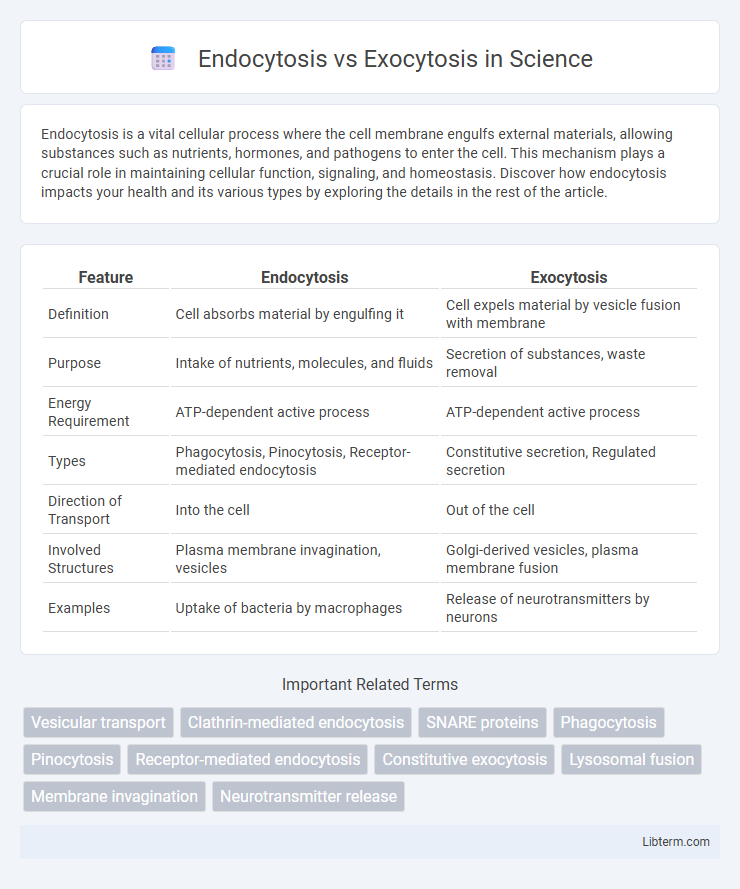Endocytosis is a vital cellular process where the cell membrane engulfs external materials, allowing substances such as nutrients, hormones, and pathogens to enter the cell. This mechanism plays a crucial role in maintaining cellular function, signaling, and homeostasis. Discover how endocytosis impacts your health and its various types by exploring the details in the rest of the article.
Table of Comparison
| Feature | Endocytosis | Exocytosis |
|---|---|---|
| Definition | Cell absorbs material by engulfing it | Cell expels material by vesicle fusion with membrane |
| Purpose | Intake of nutrients, molecules, and fluids | Secretion of substances, waste removal |
| Energy Requirement | ATP-dependent active process | ATP-dependent active process |
| Types | Phagocytosis, Pinocytosis, Receptor-mediated endocytosis | Constitutive secretion, Regulated secretion |
| Direction of Transport | Into the cell | Out of the cell |
| Involved Structures | Plasma membrane invagination, vesicles | Golgi-derived vesicles, plasma membrane fusion |
| Examples | Uptake of bacteria by macrophages | Release of neurotransmitters by neurons |
Introduction to Endocytosis and Exocytosis
Endocytosis and exocytosis are essential cellular processes involved in the transport of materials across the plasma membrane. Endocytosis enables cells to internalize extracellular substances by engulfing them into vesicles, while exocytosis facilitates the release of intracellular contents to the extracellular environment through vesicle fusion. These mechanisms are crucial for maintaining cellular homeostasis, communication, and nutrient uptake.
Defining Endocytosis
Endocytosis is a cellular process in which the cell membrane engulfs external substances, forming vesicles to transport materials into the cell. This mechanism is vital for nutrient uptake, receptor-mediated signaling, and removal of pathogens. Contrastingly, exocytosis involves vesicles fusing with the plasma membrane to release intracellular substances outside the cell.
Types of Endocytosis
Endocytosis includes types such as phagocytosis, pinocytosis, and receptor-mediated endocytosis, each facilitating the cellular intake of particles, fluids, or specific molecules respectively. Phagocytosis engulfs large particles or cells, often utilized by immune cells like macrophages, while pinocytosis involves the nonspecific uptake of extracellular fluid. Receptor-mediated endocytosis relies on receptor-ligand interactions, enabling cells to selectively internalize molecules such as cholesterol or hormones.
Mechanisms of Endocytosis
Endocytosis is a cellular process where the plasma membrane engulfs extracellular material, forming vesicles that transport substances into the cell. Key mechanisms include phagocytosis, where large particles are engulfed by membrane extensions called pseudopodia, and pinocytosis, which involves the nonspecific uptake of extracellular fluid and solutes through small vesicles. Receptor-mediated endocytosis is a selective mechanism that uses specific membrane receptors to internalize molecules such as hormones, nutrients, and viruses.
Defining Exocytosis
Exocytosis is a cellular process where materials are expelled from the cell via vesicles that fuse with the plasma membrane, releasing their contents into the extracellular space. This mechanism is essential for the secretion of hormones, neurotransmitters, and waste removal. Unlike endocytosis, which involves the uptake of substances, exocytosis facilitates outward transport, maintaining cellular homeostasis and communication.
Types of Exocytosis
Exocytosis primarily occurs in two types: constitutive and regulated. Constitutive exocytosis continuously transports molecules, such as lipids and proteins, to the plasma membrane for cell maintenance. Regulated exocytosis, common in neurons and endocrine cells, releases neurotransmitters or hormones in response to specific signals, involving vesicles that fuse with the plasma membrane upon calcium ion influx.
Mechanisms of Exocytosis
Exocytosis involves the fusion of vesicles with the plasma membrane to release intracellular substances into the extracellular environment, a process driven by SNARE proteins facilitating membrane docking and fusion. Calcium ions play a critical role in triggering vesicle fusion by promoting conformational changes in proteins like synaptotagmin, ensuring rapid neurotransmitter release in neuronal cells. This highly regulated mechanism contrasts with endocytosis, where cells internalize material by invagination of the plasma membrane to form vesicles.
Key Differences Between Endocytosis and Exocytosis
Endocytosis involves the cellular process of engulfing external substances by enclosing them in vesicles formed from the plasma membrane, while exocytosis is the mechanism where cells expel materials by merging vesicles with the plasma membrane. Endocytosis typically facilitates nutrient uptake and receptor-mediated internalization, whereas exocytosis is essential for releasing hormones, neurotransmitters, and waste products. The directionality of vesicle movement distinguishes these processes: endocytosis moves materials into the cell, whereas exocytosis moves materials out.
Biological Significance and Functions
Endocytosis and exocytosis regulate the exchange of materials between cells and their environment, crucial for maintaining cellular homeostasis. Endocytosis allows cells to internalize nutrients, signaling molecules, and pathogens, playing a key role in nutrient uptake and immune responses. Exocytosis facilitates the secretion of hormones, neurotransmitters, and waste products, essential for intercellular communication and cellular waste removal.
Summary Table: Endocytosis vs Exocytosis
Endocytosis involves the cellular intake of substances through vesicle formation, allowing cells to engulf materials like nutrients or pathogens, whereas exocytosis is the process where cells expel waste or secretory products by vesicle fusion with the plasma membrane. In endocytosis, vesicles form inwardly to bring extracellular substances into the cell, contrasting with exocytosis, where vesicles move outward to release intracellular contents. Both processes are essential for maintaining cellular homeostasis, managing material transport, and facilitating communication between cells.
Endocytosis Infographic

 libterm.com
libterm.com